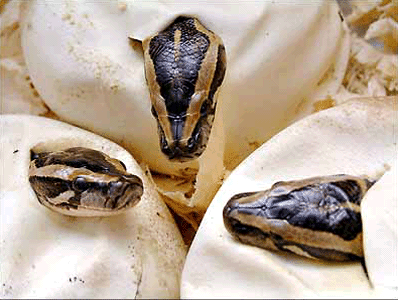Python Found in Florida Is Biggest Yet
August 17, 2012
The recent discovery of the biggest Burmese python ever found in Florida is convincing evidence of just how well established these highly destructive reptiles have become in Everglades National Park and other parts of South Florida, according to Florida scientists. The snake was 17 feet 7 inches (5.35 meters) long and weighed 164 1/2 pounds (76 kilograms). Scientists recovered 87 eggs from the snake–also a record for the state. The pythons “are surviving a long time in the wild,” said snake expert Kenneth Krysko of the Florida Museum of Natural History. “There’s nothing stopping them.” About 1,825 Burmese pythons were discovered in Everglades National Park from 2000 to 2011. However, scientists think the python population is many times higher.
Native to Southeast Asia, the python is classified as an invasive species in North America. From 1999 to 2004, pet exporters met a growing American demand for Burmese pythons by shipping more than 144,000 baby snakes to the United States. However, new owners were frequently unprepared or unwilling to care for the massive snakes in adulthood. Many owners dumped their snakes into the wild. Pythons released into the Everglades, a region with a climate similar to that of the snakes’ native habitat, flourished. Pythons also have escaped into the wild during hurricanes.

Young Indian pythons hatch from eggs outside the mother's body. The leathery shells of snake eggs expand as the young snakes grow inside. When they are ready to hatch, young snakes slash their shells with a special tooth that grows on the upper jaw. (AP/Wide World)
The pythons have devastated the mammal population of the Everglades and were targeting the park’s birds, according to a study released in April 2012. The study was the first to provide evidence linking a sharp decline in populations of medium- and large-sized mammals in the park to an explosion in the number and range of the large snakes. The record-holding snake found recently had feathers in its stomach.
Wildlife experts agree that eliminating the secretive and hard-to-hunt snakes from the park would be impossible. They are unsure if the spread of the snakes, which have no natural predators in North America, can be halted. In January, the administration of President Barack Obama outlawed the import and interstate commerce of Burmese pythons, two other pythons, and the yellow anaconda. Reptile importers are still allowed to trade in reticulated pythons and boa constrictors. Florida permits residents to hunt pythons under certain conditions.
Additional World Book articles:
- Ecology
- Invasive Species (A Special Report)
- Reptile


